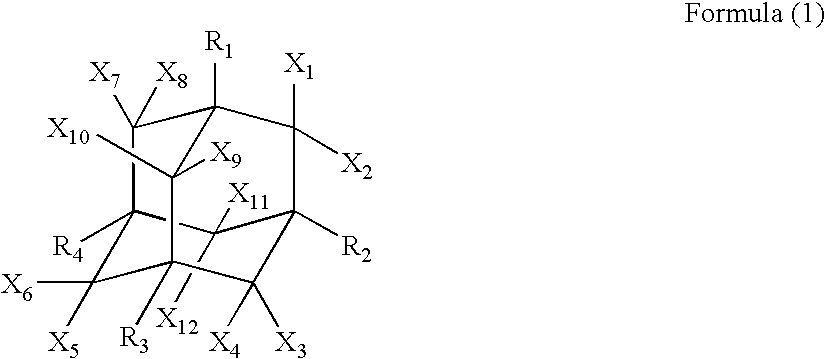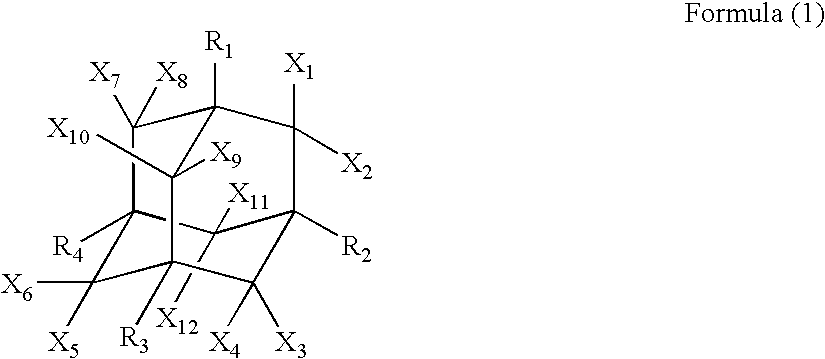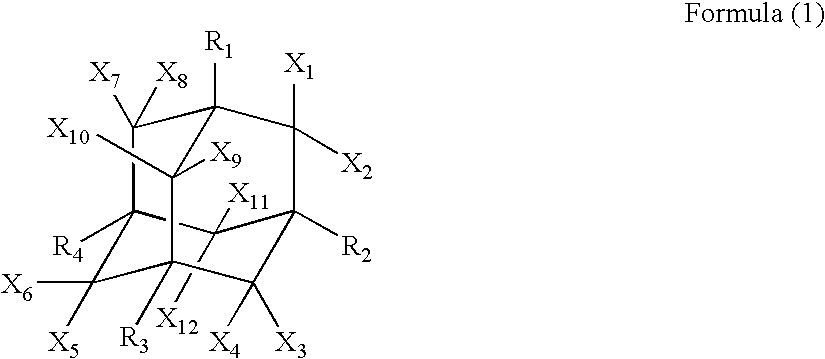Organic electroluminescence element
a technology of electroluminescence element and organic material, applied in the direction of discharge tube/lamp details, discharge tube luminescnet screen, organic semiconductor device, etc., can solve the problems of large improvement in light-emission efficiency and drive durability, and the effect of lowering the driving voltag
- Summary
- Abstract
- Description
- Claims
- Application Information
AI Technical Summary
Benefits of technology
Problems solved by technology
Method used
Image
Examples
example 1
1. Preparation of Organic EL Element
[0233](Preparation of Comparative Organic EL Element A1)
[0234]1) Formation of Anode
[0235]As a transparent substrate, the one in which indium tin oxide (which is referred to hereinafter as ITO) was deposited on a glass substrate having a size of 25 mm×25 mm×0.7 mm to form a film having a thickness of 100 nm (manufactured by Tokyo Sanyo Vacuum Co., Ltd.) was used. The transparent substrate was subjected to etching and cleaning.
[0236]2) Hole Injection Layer and Hole Transport Layer
[0237]On the resulting ITO glass substrate, copper phthalocyanine (which is referred to hereinafter as CuPc) was deposited at a thickness of 10 nm, and then, N,N′-dinaphthyl-N,N′-diphenyl-[1,1′-biphenyl]-4,4′-diamine (which is referred to hereinafter as α-NPD) was deposited at a thickness of 50 nm.
[0238]3) Light-Emitting Layer
[0239]On the hole injection layer and hole transport layer, compound (AD-1) of formula (1) and platinum complex Pt-1 as an electron-transporting light...
example 2
1. Preparation of Sample
[0267](Preparation of Organic EL Element No. 5)
[0268]Preparation of inventive organic EL element No. 5 was conducted in a similar manner to the process in the preparation of the organic EL element No. 1 of Example 1, except that, in the preparation of the organic EL element No. 1 of Example 1, the following layer was used as the light-emitting layer.
[0269]Ternary element co-deposition was conducted using hole-transporting host material mCP, compound (AD-2) of formula (1), and electron-transporting light-emitting material Pt-1, so that the weight ratio of mCP:AD-2:Pt-1 would be 70:15:15. The deposition thickness was 30 nm.
[0270](Preparation of Organic EL Element No. 6)
[0271]Preparation of inventive organic EL element No. 6 was conducted in a similar manner to the process in the preparation of the organic EL element No. 1 of Example 1, except that, in the preparation of the organic EL element No. 1 of Example 1, the following layer was used as the light-emittin...
example 3
1. Preparation of Organic EL Element Nos. 11 to 16
[0275]Preparation of inventive organic EL element Nos. 11 to 16 was conducted in a similar manner to that in the process in the preparation of the organic EL element No. 3 of Example 1, except that, in the preparation of the organic EL element No. 3 of Example 1, the compound(s) shown in Table 3 was (were) used as the compound of formula (1) in the light-emitting layer with the mixing ratio shown in Table 3. In each element, the content of the light emitting material Pt-1 was kept constant to be 15% by weight. In Table 3, when the total amount of the compounds of formula (1) exceeds 35% by weight, the content of the host material mCP is reduced for adjustment.
2. Performance Evaluation
[0276]Concerning the obtained elements, performance was evaluated in a similar manner to that in Example 1. Results are shown in Table 3.
[0277]It is clear from the results shown in Table 3 that the inventive element Nos. 11 to 16 have light-emission cha...
PUM
 Login to View More
Login to View More Abstract
Description
Claims
Application Information
 Login to View More
Login to View More - R&D
- Intellectual Property
- Life Sciences
- Materials
- Tech Scout
- Unparalleled Data Quality
- Higher Quality Content
- 60% Fewer Hallucinations
Browse by: Latest US Patents, China's latest patents, Technical Efficacy Thesaurus, Application Domain, Technology Topic, Popular Technical Reports.
© 2025 PatSnap. All rights reserved.Legal|Privacy policy|Modern Slavery Act Transparency Statement|Sitemap|About US| Contact US: help@patsnap.com



